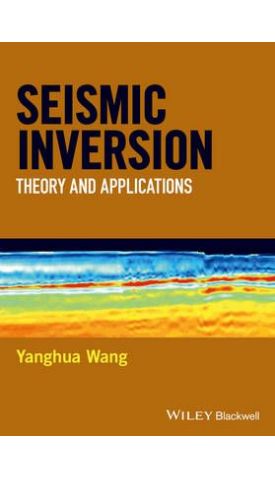אנו משתמשים ב-Cookies כדי לשפר את החוויה שלך. כדי לקיים ההנחיה החדשה של e-Privacy, עלינו לבקש את הסכמתך להגדיר את ה-Cookies. קבלת מידע נוסף.
404.00 ₪
Seismic Inversion - Theory and Applications
404.00 ₪
ISBN13
9781119257981
יצא לאור ב
Hoboken
זמן אספקה
21 ימי עסקים
עמודים
256
פורמט
Hardback
תאריך יציאה לאור
4 בנוב׳ 2016
Seismic inversion aims to reconstruct a quantitative model of the Earth subsurface, by solving an inverse problem based on seismic measurements. There are at least three fundamental issues to be solved simultaneously: non-linearity, non-uniqueness, and instability.
Seismic inversion aims to reconstruct a quantitative model of the Earth subsurface, by solving an inverse problem based on seismic measurements. There are at least three fundamental issues to be solved simultaneously: non-linearity, non-uniqueness, and instability. This book covers the basic theory and techniques used in seismic inversion, corresponding to these three issues, emphasising the physical interpretation of theoretical concepts and practical solutions. This book is written for master and doctoral students who need to understand the mathematical tools and the engineering aspects of the inverse problem needed to obtain geophysically meaningful solutions. Building on the basic theory of linear inverse problems, the methodologies of seismic inversion are explained in detail, including ray-impedance inversion and waveform tomography etc. The application methodologies are categorised into convolutional and wave-equation based groups. This systematic presentation simplifies the subject and enables an in-depth understanding of seismic inversion.
This book also provides a practical guide to reservoir geophysicists who are attempting quantitative reservoir characterisation based on seismic data. Philosophically, the seismic inverse problem allows for a range of possible solutions, but the techniques described herein enable geophysicists to exclude models that cannot satisfy the available data. This book summarises the author s extensive experience in both industry and academia and includes innovative techniques not previously published.
| עמודים | 256 |
|---|---|
| פורמט | Hardback |
| ISBN10 | 1119257980 |
| יצא לאור ב | Hoboken |
| תאריך יציאה לאור | 4 בנוב׳ 2016 |
| תוכן עניינים | Preface viii Chapter 1 Basics of seismic inversion 1 1.1 The linear inverse problem 1 1.2 Data, model and mapping 3 1.3 General solutions 4 1.4 Regularisation 5 Chapter 2 Linear systems for inversion 11 2.1 A governing equation and its solution 11 2.2 Seismic scattering 14 2.3 Seismic imaging 16 2.4 Seismic downward continuation 18 2.5 Seismic data processing 20 Chapter 3 Least-squares solutions 23 3.1 Determinant and rank 23 3.2 The inverse of a square matrix 27 3.3 LU decomposition and Cholesky factorisation 28 3.4 Least-squares solutions 34 3.5 Least-squares solution for a nonlinear system 37 3.6 Least-squares solution by QR decomposition 37 Chapter 4 Singular value analysis 41 4.1 Eigenvalues and eigenvectors 41 4.2 Singular value concept 44 4.3 Generalised inverse solution by SVD 46 4.4 SVD applications 48 Chapter 5 Gradient-based methods 53 5.1 The step length 54 5.2 The steepest descent method 55 5.3 Conjugate gradient method 59 5.4 Biconjugate gradient method 61 5.5 The subspace gradient method 64 Chapter 6 Regularisation 67 6.1 Regularisation versus conditional probability 67 6.2 The Lp-norm constraint 70 6.3 The maximum entropy constraint 73 6.4 The Cauchy constraint 76 6.5 Comparison of various regularisations 79 Chapter 7 Localised average solutions 83 7.1 The average solution 84 7.2 The deltaness 85 7.3 The spread criterion 86 7.4 The Backus-Gilbert stable solution 88 Chapter 8 Seismic wavelet estimation 93 8.1 Wavelet extraction from seismic-to-well correlation 94 8.2 Constant-phase wavelet by kurtosis matching 98 8.3 Mixed-phase wavelet by cumulant matching 102 8.4 Generalised seismic wavelets 106 Chapter 9 Seismic reflectivity inversion 111 9.1 The least-squares problem with a Gaussian constraint 111 9.2 Reflectivity inversion with an Lp-norm constraint 113 9.3 Reflectivity inversion with the Cauchy constraint 115 9.4 Multichannel inversion scheme 118 9.5 Multichannel conjugate gradient method 121 Chapter 10 Seismic ray-impedance inversion 125 10.1 Acoustic and elastic impedances 125 10.2 Ray impedance 129 10.3 Workflow of ray-impedance inversion 132 10.4 Ray-impedance inversion with a model constraint 136 Chapter 11 Seismic tomography based on ray theory 137 11.1 Seismic tomography 137 11.2 Velocity-depth ambiguity in tomography 138 11.3 Ray tracing by a path bending method 141 11.4 Geometrical spreading of curved interfaces 144 11.5 Joint inversion of traveltime and amplitude data 147 Chapter 12 Waveform tomography for the velocity model 153 12.1 Inverse theory for seismic waveform tomography 154 12.2 The optimal step length 157 12.3 Strategy for reflection seismic tomography 159 12.4 Multiple attenuation and partial compensation 162 12.5 Waveform tomography 166 Chapter 13 Waveform tomography with irregular topography 169 13.1 Body-fitted grids for finite-difference modelling 169 13.2 Modification of boundary points 172 13.3 Pseudo-orthogonality and smoothness 173 13.4 Wave equation and absorbing boundary condition 176 13.5 Waveform tomography with irregular topography 180 Chapter 14 Waveform tomography for seismic impedance 183 14.1 Wave equation and model parameterisation 185 14.2 The impedance inversion method 187 14.3 Inversion strategies and the inversion flow 188 14.4 Application to field seismic data 193 14.5 Conclusions 196 Appendices 197 A Householder transform for QR decomposition 197 B Singular value decomposition 200 C Iterative methods for solving a linear system 206 D Biconjugate gradient method for complex systems 209 Exercises and solutions 211 References 231 Author index 238 Subject index 240 |
| זמן אספקה | 21 ימי עסקים |



Login and Registration Form